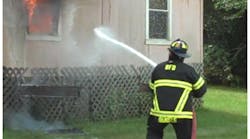Providing your firefighters with a worthwhile training experience can be a challenging task for a training officer. We attempt to not fall into the same routines and have the same drills during the same season, or have them fall on the same time of year annually (while easier, volunteer departments will notice a decrease in attendance over time). Many times this can’t be helped and they are necessary to be completed at certain times (refresher course on standard operating guidelines (SOGs) or blood borne pathogen training, etc.). However, throughout the time period of your training schedule, there should be openings to bring up topics that will provide new drills for training, or times when you look through department tactics and find that certain things are out of date and could use a bit of reworking.
Many topics for discussion that can be used for new training material are at your fingertips in this day and age of on-demand technology. These lessons can come from any place, but this article is going to focus exclusively on YouTube. This internet source can provide you with multiple drill segments on a variety of topics. Specifically, YouTube puts amateur drill video makers on the web for free and there are many videos on hose advancement, forcible entry, search, and whatever else you are looking for as a drill subject. YouTube also has videos that show fire departments in action; which in many cases are shot from helmet cams or other fire department-approved video sources (example: someone in the department or a friend of the department shot the video). Other video sources from the public are also on the site (but are less likely to show the important items we as firefighters would find as good material for analysis).
Using YouTube during a drill can be a very rewarding tool as a presenter; it takes some of the pressure off of you being front and center as you are just making observations and queuing the group while they are focused on the video presented. It also exposes your firefighters to different and more “out-of-the-box” scenarios that have occurred elsewhere, and maybe responses that your department haven’t discussed about how to handle. Remember, mutual aid calls come in a variety of forms, near and far. While the spectacular events are on the web, there are also unlimited videos on what can be called “bread-and-butter” responses. These videos are a bit more important for firefighters to focus on when conducting certain drills. The topics that could be covered on a conventional house fire can lead back to my previous article about engagement during drills.
The First 30 Seconds
The great thing about using this source is that there is virtually an unlimited amount of information available from what has been posted to the site. Many fire videos have the same components, the first images presented of the video can allow for officers to give an initial on-scene size-up of what they are encountering. Drivers and senior firefighters can discuss apparatus placement for engines and ladders as they are approaching. Engine firefighters can discuss what hoselines to stretch and where to place them, routes of entry, and last, but certainly not least, truck members can discuss how and where to ventilate. These discussions can all occur within the first 15-30 seconds of the video being played. This conversation could last several minutes and include members of all experience levels.
After everyone has discussed tactics and equipment placement, begin an open discussion on your department SOGs while watching the rest of the video. While SOGs differ from department to department, you can discuss what your apparatus placement should look like in accordance with your department’s guidelines and what the initial size-up is presenting. During the duration of the video, continual reminders of what the department SOGs state are important to build the memory for junior members who are still learning. An effective tool for SOG learning is to ask the members of your department questions in regards to the guidelines, such as: How many handlines can you charge off the booster tank? Are the ladder placements correct?
Preparation using YouTube videos can be a very time consuming task because you may have to watch many videos from start to finish, in order to find videos that match your drill topic. While this does take time, you can also just watch parts of videos, take snippets of items from several videos and watch those; sometimes compilations dedicated to just engine/truck work, or fires in specific building types can be effective. While watching the videos, compile a list of ones that meet your criteria of the subject and few that also bring in a few other topics that you can use as refresher points. Hitting multiple SOGs during a drill keeps everyone on their toes, and also shows members how the SOGs work with each other.
Avoiding Knitpicking
One pitfall that can strike members and instructors participating in a drill like this is going from critical analysis and application, to criticism. Critical analysis and criticism can sometimes be a thin line of division, and other times, far reaches from each other. As drill instructors, we must prepare our lessons so that this line has a very limited ability to be reached or, even worse, crossed. Part of your preparation for the drill should be to watch the videos all the way through to ensure they will provide quality moments of instruction. Videos that appear to be pointing out mistakes or are titled with a negative connotation should definitely be avoided, as they will detract from the focus of the drill.
However during the course of the drill, no matter the amount of preparation to prevent criticism, sometimes small snickering comments can be heard in the background. As an instructor, it is your task to keep everyone on topic and not allow the background comments to gain traction to become a more focal point in the conversation. A safe way to bring everyone back is to say, “We are watching an unsolicited fire department video and they do things differently than we do. Who says there aren’t other videos out on the web where companies sit and laugh at us for how we do things. We all learn from each other.” Using statements like this or other motivational tools to keep the audience in line and on focus is important.
Like any good tool, this is best used occasionally, so that repetition doesn’t develop and firefighters become bored with drilling. As drill instructors, we need to motivate ourselves and challenge ourselves to create interesting and different drill presentations. This is just a suggestion, but something that is different than a hands-on approach or a lecture. For those who haven’t tried this as an approach, feel free to email me or leave a comment at the bottom to share how it goes. For those who have had the opportunity to use this in the past, also feel free to share your tips and experiences.
SEAN WILKINSON is a captain and drill instructor with the Snyder Fire Department in Amherst, NY. He is a police dispatcher for the Town of Amherst Police and is the manager of an Urgent Care Center. He has a Bachelors of Arts in History from the University at Buffalo, and is currently completing the requirements for his Masters in Secondary Education at the University at Buffalo. You can contact Sean at: [email protected].








